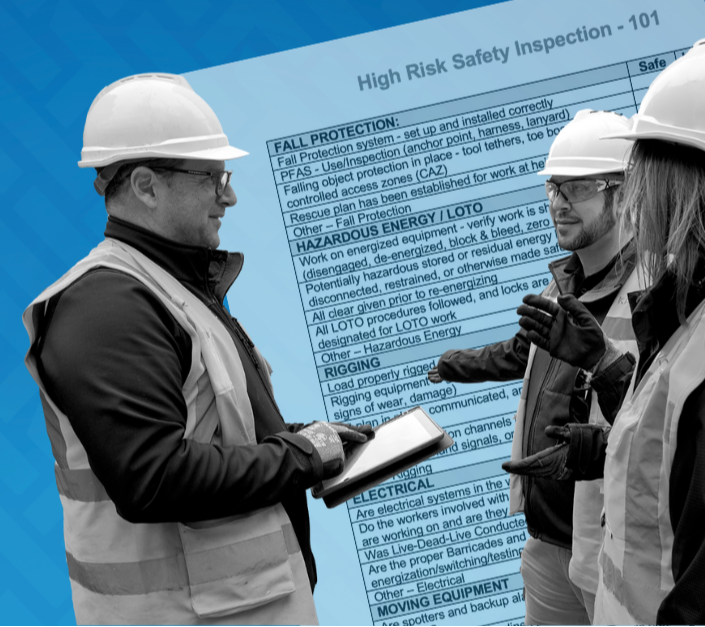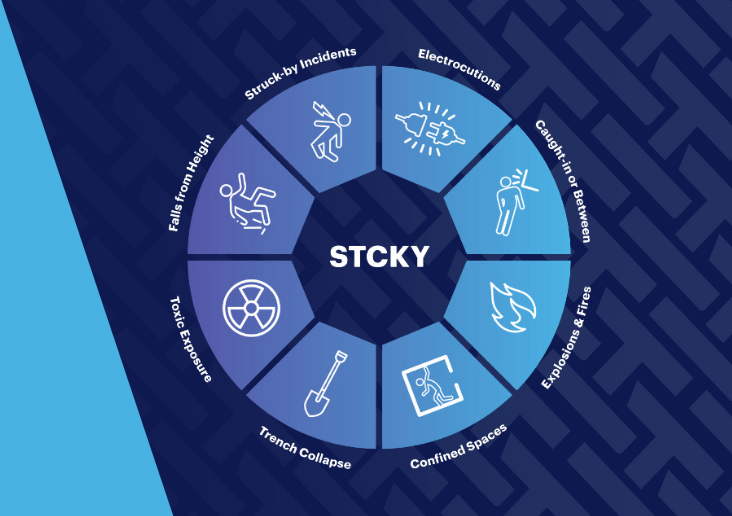What's Inside |
|
|
Recent PSIF & STCKY Webinar Highlight Reel
WATCH NOW!
The term PSIF (Potential for Serious Incident or Fatality), also known as STCKY (Stuff That Can Kill You - a registered trademark of Sundt Construction, used by HammerTech with permission) has gained significant attention in the construction industry and signifies a shift in the way we view safety. A key component of contemporary occupational safety, PSIF moves the emphasis from reactive measures to proactive risk management.
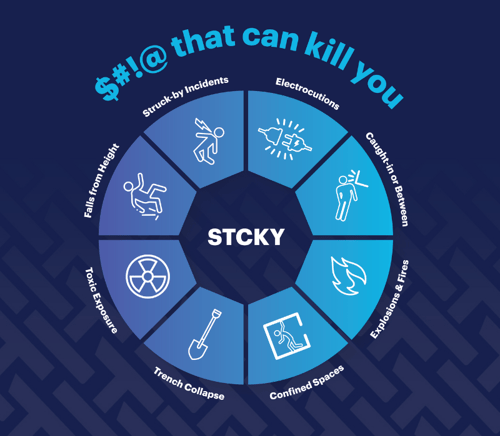
are used by HammerTech with permission from Sundt Construction.
Download a copy of this STCKY chart for your construction site!
The History + and Evolution of PSIF
In many industries, with advancements in safety regulations, total injury and illness rates have declined in recent years. However, rates of fatalities and serious injuries have not declined. This suggests that while traditional approaches to safety and health have worked to reduce incidents overall, they have not been as successful at preventing serious incidents. As a result, researchers and professionals are seeking new approaches for effective risk assessment and planning; one such innovation is the concept of PSIF.
PSIF has helped advance construction safety, emphasizing prevention and identifying the potential for major incidents before they happen. It refocuses attention from lower-severity events to those that have the greatest potential to cause extreme harm or death.
Dylan Hipple, a Certified Safety Professional (CSP) and Construction Health and Safety Technician (CHST) with over a decade of experience says that PSIF has been “gaining significant traction in recent years” and explained that "tracking and learning from PSIF data is key to preventing serious incidents in our industry.”
Understanding the Paradigm Shift in Construction Safety
The shift towards focusing on PSIF-related hazards marks a departure from traditional views, like Heinrich's Triangle Theory. Heinrich’s theory suggests that for every 1 major incident, there are 29 minor incidents and 300 non-injuries or near misses. Traditionally, every incident was treated the same, regardless of severity, with the goal of investigating common root causes.
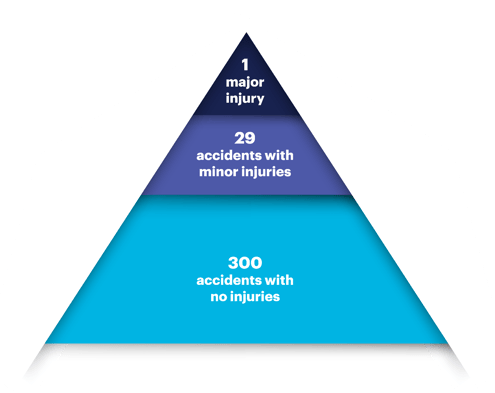
In contrast, the new perspective of PSIF prioritizes anticipating potentially serious incidents. When applying this perspective to Heinrich’s triangle theory, it was determined that more than 20% of the 300 near misses have the potential to be serious incidents. Hipple elaborates, “When we start to look back at those 300 near misses, we quickly realize that there were multiple events that had the potential to cause a serious injury. They were hiding in plain sight. One does not equal one when it comes to incidents”.
Identifying and Addressing PSIF Hazards During Planning
Effective PSIF integration starts in the planning phase and having a well-defined process for identifying PSIF hazards early is key. Hipple highlighted the importance of early identification of high-risk activities, noting, “the focus for our teams should be on activities that have the greater potential for high severity incidents.”
Historical data and common construction knowledge tell us which types of activities have the potential to lead to serious incidents. “When reviewing the scope of a project, it is clear which activities should be planned more thoroughly” Hipple explained.
Following the identification of PSIF hazards, it is essential to implement a strategic plan that helps mitigate these risks by reducing severity and exposure levels.
PSIF in Day-to-Day Operations
Incorporating PSIF awareness into daily routines transforms standard audits and safety checks. For example, daily PTP plans with enhanced workflows around high-risk activities, and safety audits that shift focus towards high-risk activities like working at heights or crane operations help team members identify and mitigate risks more effectively. Hipple explains, "We're trying to identify potential issues early and ensure we have a plan for mitigation before we get to a point where we have SIF potential."
A key part of integrating PSIF into daily operations is collecting PSIF data during event investigation. “This is critical to ensuring a successful program”, says Hipple. One valuable use for PSIF data is the analysis of near-miss incidents, which can be an indicator of underlying risks. Recognizing and analyzing near misses provides important insights for preventing future SIF incidents and oftentimes can spark much-needed corrective actions.

PSIF for General Contractors & Owners
For General Contractors (GCs) and Owners, understanding and integrating PSIF into project planning is essential to advancing workplace safety. Not only does a PSIF program enhance worker well-being, but it also significantly impacts a company's financial status and reputation.
Hipple explained, “For me, it's realizing that the majority of our observations are non-PSIF but understanding how big of an impact that small percentage of PSIFs actually has. This is why we are starting to shift toward this PSIF mentality: we can quickly see that a small percentage is causing the most pain points within the organization, and leading to our most serious incidents. That’s what’s causing our loss of revenue.”
Focusing on PSIFs, teams can proactively address high-risk scenarios, ensuring preventive measures are in place before incidents happen.
How to Make PSIF a Success
-
Reporting, Data, and the Continuous Improvement Loop
The importance of PSIF reporting lies in its ability to provide data-driven insights into the safety landscape of a project, allowing for informed decision-making. This data-driven approach is the backbone of the Continuous Improvement Loop, a process wherein safety practices are constantly evaluated and enhanced based on the latest information. With such approaches, integrating PSIF metrics into project planning helps mitigate risks and fosters a culture of safety awareness and responsibility.
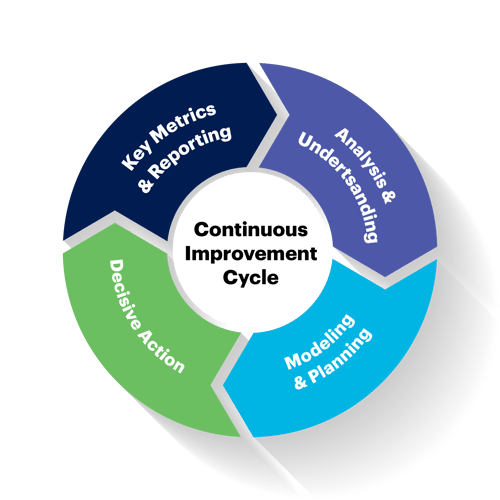
-
Training and Awareness Around PSIF
To effectively educate their teams about PSIF and SIF prevention, leaders should utilize top resources such as industry-specific safety seminars, workshops conducted by occupational health and safety experts, and online courses focusing on PSIF identification and management.
Future Challenges of PSIF
Looking ahead, Hipple believes PSIF will become more routinely used in construction, though challenges remain. "One of the greatest challenges is understanding what to do with the data," he states. To be effective, PSIF data needs to inform actionable strategies. It is essential for teams to build a process that not only collects data but analyzes and uses that data to continually improve their safety program.
Next Steps Towards a Safer Construction Industry
PSIF programs represent a significant step forward in safety for construction and general manufacturing workplaces, shifting focus to the most severe risks.
For owners and general contractors, integrating PSIF into their programs is a regulatory necessity and a moral obligation to protect their workforce. As Hipple noted, "in a perfect world, we would have this topic discussed at different intervals throughout the project," ensuring a comprehensive approach to safety. With innovations including PSIF, the construction industry is poised for a safer, more secure future through proactive measures, training, and ongoing risk management.
Learn more about how HammerTech can simplify PSIF practices for you. https://www.hammertech.com/en-us/solutions/safety



%20GIF.gif?width=200&name=HammerTech%20Intelligence%20(HTI)%20GIF.gif)

.png)
.png?width=150&name=USA%20-%20Worker%20Thumbs%20up%20(9).png)
